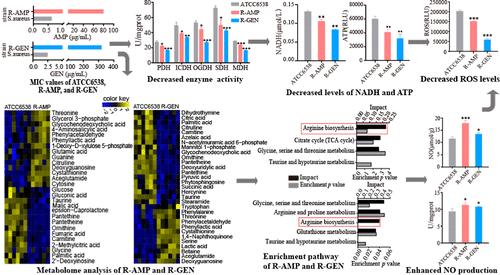Comparative Metabolomics Reveals Changes in the Metabolic Pathways of Ampicillin- and Gentamicin-Resistant Staphylococcus aureus
IF 4.3
3区 材料科学
Q1 ENGINEERING, ELECTRICAL & ELECTRONIC
引用次数: 0
Abstract
Antibiotic resistance is a major global challenge requiring new treatments and a better understanding of the bacterial resistance mechanisms. In this study, we compared ampicillin-resistant (R-AMP) and gentamicin-resistant (R-GEN) Staphylococcus aureus strains with a sensitive strain (ATCC6538) using metabolomics. We identified 109 metabolites; 28 or 31 metabolites in R-AMP or R-GEN differed from those in ATCC6538. Moreover, R-AMP and R-GEN were enriched in five and four pathways, respectively. R-AMP showed significantly up-regulated amino acid metabolism and down-regulated energy metabolism, whereas R-GEN exhibited an overall decrease in metabolism, including carbohydrate, energy, and amino acid metabolism. Furthermore, the activities of the metabolism-related enzymes pyruvate dehydrogenase and TCA cycle dehydrogenases were inhibited in antibiotic-resistant bacteria. Significant decreases in NADH and ATP levels were also observed. In addition, the arginine biosynthesis pathway, which is related to nitric oxide (NO) production, was enriched in both antibiotic-resistant strains. Enhanced NO synthase activity in S. aureus promoted NO production, which further reduced reactive oxygen species, mediating the development of bacterial resistance to ampicillin and gentamicin. This study reveals that bacterial resistance affects metabolic profile, and changes in energy metabolism and arginine biosynthesis are important factors leading to drug resistance in S. aureus.

比较代谢组学揭示耐氨苄西林和庆大霉素金黄色葡萄球菌代谢途径的变化
抗生素耐药性是一项重大的全球性挑战,需要新的治疗方法和更好地了解细菌的耐药性机制。在这项研究中,我们利用代谢组学方法比较了耐氨苄西林(R-AMP)和耐庆大霉素(R-GEN)的金黄色葡萄球菌菌株与敏感菌株(ATCC6538)。我们鉴定了 109 种代谢物,其中 28 或 31 种代谢物在 R-AMP 或 R-GEN 中与 ATCC6538 中不同。此外,R-AMP 和 R-GEN 分别在五条和四条通路中富集。R-AMP的氨基酸代谢明显上调,能量代谢下调,而R-GEN的代谢则整体下降,包括碳水化合物、能量和氨基酸代谢。此外,抗生素耐药细菌中与新陈代谢相关的丙酮酸脱氢酶和 TCA 循环脱氢酶的活性也受到了抑制。还观察到 NADH 和 ATP 水平显著下降。此外,与一氧化氮(NO)产生有关的精氨酸生物合成途径在两种抗生素耐药菌株中都得到了丰富。金黄色葡萄球菌中增强的一氧化氮合成酶活性促进了一氧化氮的产生,从而进一步减少了活性氧,介导了细菌对氨苄西林和庆大霉素耐药性的产生。这项研究揭示了细菌耐药性会影响代谢概况,能量代谢和精氨酸生物合成的变化是导致金黄色葡萄球菌耐药性的重要因素。
本文章由计算机程序翻译,如有差异,请以英文原文为准。
求助全文
约1分钟内获得全文
求助全文

 求助内容:
求助内容: 应助结果提醒方式:
应助结果提醒方式:


